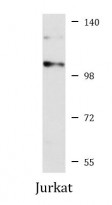ARG59377
anti-PTPN22 antibody
anti-PTPN22 antibody for ICC/IF,Western blot and Human,Mouse,Rat
Overview
| Product Description | Rabbit Polyclonal antibody recognizes PTPN22 |
|---|---|
| Tested Reactivity | Hu, Ms, Rat |
| Tested Application | ICC/IF, WB |
| Host | Rabbit |
| Clonality | Polyclonal |
| Isotype | IgG |
| Target Name | PTPN22 |
| Antigen Species | Human |
| Immunogen | Recombinant fusion protein corresponding to aa. 1-90 of Human PTPN22 (NP_036543.4). |
| Conjugation | Un-conjugated |
| Alternate Names | LYP1; Lymphoid phosphatase; LYP2; LYP; Hematopoietic cell protein-tyrosine phosphatase 70Z-PEP; PEP; PTPN8; Tyrosine-protein phosphatase non-receptor type 22; PEST-domain phosphatase; LyP; EC 3.1.3.48 |
Application Instructions
| Application Suggestion |
|
||||||
|---|---|---|---|---|---|---|---|
| Application Note | * The dilutions indicate recommended starting dilutions and the optimal dilutions or concentrations should be determined by the scientist. | ||||||
| Positive Control | Jurkat | ||||||
| Observed Size | 107 kDa |
Properties
| Form | Liquid |
|---|---|
| Purification | Affinity purified. |
| Buffer | PBS (pH 7.3), 0.02% Sodium azide and 50% Glycerol. |
| Preservative | 0.02% Sodium azide |
| Stabilizer | 50% Glycerol |
| Storage Instruction | For continuous use, store undiluted antibody at 2-8°C for up to a week. For long-term storage, aliquot and store at -20°C. Storage in frost free freezers is not recommended. Avoid repeated freeze/thaw cycles. Suggest spin the vial prior to opening. The antibody solution should be gently mixed before use. |
| Note | For laboratory research only, not for drug, diagnostic or other use. |
Bioinformation
| Database Links |
Swiss-port # P29352 Mouse Tyrosine-protein phosphatase non-receptor type 22 Swiss-port # Q9Y2R2 Human Tyrosine-protein phosphatase non-receptor type 22 |
|---|---|
| Gene Symbol | PTPN22 |
| Gene Full Name | protein tyrosine phosphatase, non-receptor type 22 (lymphoid) |
| Background | This gene encodes of member of the non-receptor class 4 subfamily of the protein-tyrosine phosphatase family. The encoded protein is a lymphoid-specific intracellular phosphatase that associates with the molecular adapter protein CBL and may be involved in regulating CBL function in the T-cell receptor signaling pathway. Mutations in this gene may be associated with a range of autoimmune disorders including Type 1 Diabetes, rheumatoid arthritis, systemic lupus erythematosus and Graves' disease. Alternatively spliced transcript variants encoding distinct isoforms have been described. [provided by RefSeq, Mar 2009] |
| Function | Acts as negative regulator of T-cell receptor (TCR) signaling by direct dephosphorylation of the Src family kinases LCK and FYN, ITAMs of the TCRz/CD3 complex, as well as ZAP70, VAV, VCP and other key signaling molecules. Associates with and probably dephosphorylates CBL. Dephosphorylates LCK at its activating 'Tyr-394' residue. Dephosphorylates ZAP70 at its activating 'Tyr-493' residue. Dephosphorylates the immune system activator SKAP2. Positively regulates toll-like receptor (TLR)-induced type 1 interferon production. Promotes host antiviral responses mediated by type 1 interferon (By similarity). Regulates NOD2-induced pro-inflammatory cytokine secretion and autophagy. [UniProt] |
| Cellular Localization | Cytoplasm. [UniProt] |
| Calculated MW | 92 kDa |
| PTM | Phosphorylation on Ser-35 by PKC/PRKCD abrogates its ability to dephosphorylate and inactivate the SRC family kinases. [UniProt] |
Images (1) Click the Picture to Zoom In






